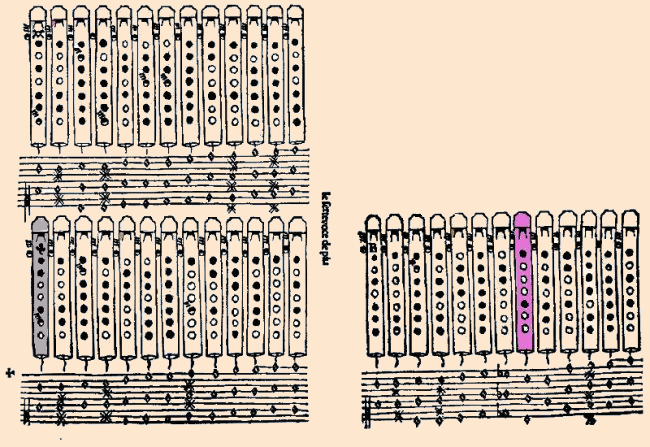PHILIPPE BOLTON
HANDMADE RECORDERS & FLAGEOLETS
Can we really speak of a Ganassi fingering system?
Sylvestro Ganassi's treatise, La Fontegara, contains three charts for high notes above the normal range for a recorder of the time (an octave and a sixth), for three instruments on which he experimented to find new fingerings. Each one is identified by a maker's mark on the left.

In these charts ![]() = leaking or partially closed hole.
= leaking or partially closed hole.
In the following picture every note has been coloured differently to facilitate identification. Alternative and missing fingerings are more easily seen for the three recorders on which Ganassi experimented. These fingerings use the second register to the top of the second octave, followed directly by the 4th register for higher notes. However the third chart below reveals some exceptions.
For more information about registers see the page on how recorders work.

In the next picture the notes and fingerings have been taken out of their original charts and grouped together for easier identification of the variant fingerings and missing notes. The maker's mark is shown on each instrument.

Two of the high notes in Ganassi's charts seem to belong to the 3rd register, which is uncommon for recorders of the first half of the XVIth century. They are coloured in the following chart.

Ganassi's fingering, usually too high
 |
The 3rd fingering in each of the fingering charts (left), should give a high g on an alto in g, or a high c on an instrument in c, but it usually sounds too high on modern "Ganassi" recorders.
This can be corrected by closing the thumb hole completely and making hole n° 6 leak (right). In either case we have a 4th register note. Il peut être corrigé en fermant complètement le trou de pouce et en laissant une fuite au trou n° 6 (à droite). L'un comme l'autre appartiennent au 4e registre. |
An alternate fingering with better intonation

|
Ganassi's fingering

|
The second fingering in each of these high note charts (left) is almost the same as the one given in 1646 by Blankenburgh for high b on a soprano recorder (right). They are both 2nd register notes. |
Blankenburgh's equivalent fingering for high b
|
SAM 135
© khm |
Ganassi's high note charts are not limited to one and only bore profile, since they were derived from instruments by three different makers. Some of the notes can in fact be played on several original 16th recorders. It is interesting to note that these fingerings cannot be used on the famous alto recorder in g n° SAM 135 in the Kunsthistorischesmuseum in Vienna, from which most of the modern "Ganassi" recorders have been derived. Its range does not exceed one octave and a sixth, and it is now believed to be a consort recorder. Click here or on the picture on the left for more information on this instrument. These charts are probably more experimental than musical, since high g is only used six times and high a twice in all the exercises contained in La Fontegara. The other third octave notes are not included at all. This could mean that Ganassi did not consider them to be usable in a musical context. |